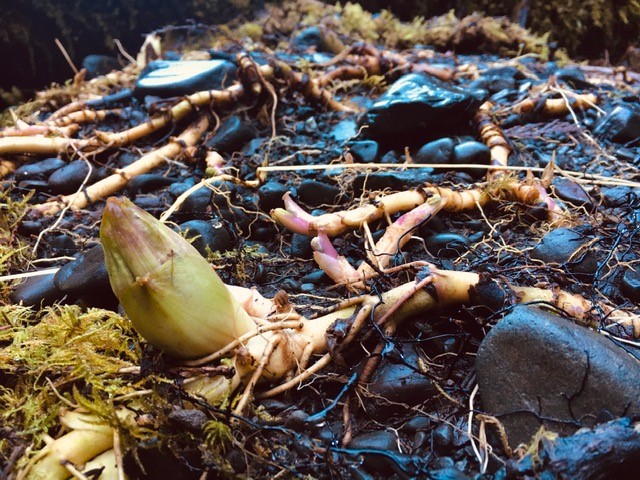
Plants in Winter
Photo Above***Coltsfoot (Petasites frigidus) flower stem and rhizomes, getting ready to emerge as one of springs first flowers.
In the depths of winter, plant life in your garden and backyard is probably a bit on slow mode. The short days and cold temperatures bring suspended animation and growth, making some vegetation look shriveled, or even dead. But make no mistake, within the plants, or underneath the surface, there is still a whole lot of science and systems at play.
Plants have evolved a variety of techniques to be able to survive winter. The period of dormancy, where plants are alive, but not growing, is a survival mechanism designed to help the plant endure the cold and be best prepared for the warmer and greener days ahead.
When cold sets in, many woody plants such as shrubs and trees become “hardened.” Water in the plant cells is pumped into the roots, and the stored sugar and minerals throughout the plant mix together to create a natural antifreeze.
Herbaceous plants have two main strategies for getting through the cold season. Annuals complete their life cycle in one growing season to avoid the cold season. They grow, reproduce, and survive only as seeds that will germinate the following spring. Perennials stalks and leaves die off in winter, but the underground parts (roots, bulbs, rhizomes, tubers) remain alive, storing food reserves from summer and autumn that will be used to get a head start to grow leaves and shoots when spring comes. Hiding in the soil is a good bet as soil does not get quite as cold, or fluctuate, in temperature as much as air.
Certain seeds from both annual and perennial species not only tolerate the cold, but actually require it. Seeds with hard, bony coats need the harsh wind and rains of winter to soften the tough seed coat, a necessary step for germination when the conditions are right.
Deciduous trees shed their leaves before winter, in part to avoid damage from weather, and lighten their load. In areas where optimal growing season is brief, plants are more often evergreen to save energy by not needing to regrow new leaves each year. The leaves of evergreens are also more resistant to cold and moisture loss. Both the long thin needles of pine and fir trees, and the waxy, tough broad leaves of plants like Salal (Gaultheria shallon) and Oregon grape (Mahonia aquifolium) are adapted for dealing with cold weather.
Plants in the mountains have acclimatized in other ways. In areas that receive frequent snow, trees may grow closer to the ground, or take on shapes that help them shed snow more easily, such as the short, stiff branches of sub-alpine fir (Abies lasiocarpa). Plants in these zones use snow for insulation, like a blanket that protects their roots against the extreme cold.
While winter might feel long and harsh, our favorite plants are doing just fine, and some are already revealing that spring is on its way….

Railroad Bridge Park
1/29/21

Pacific Rhododendon (Rhododendron macrophyllum)

